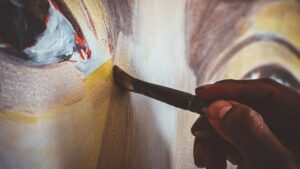When it comes to transforming a canvas into a stunning work of art, the foundation matters. Whether you’re a seasoned artist or a DIY enthusiast embarking on a home project, the question of priming the canvas before painting often arises. Let’s dive into this crucial step and uncover why priming might just be the key to unlocking the full potential of your masterpiece.
Why Prime the Canvas?
Introduction to Priming
Priming a canvas is like preparing a blank canvas for the artist’s vision. It’s a preparatory step that sets the stage for the paint to adhere better, ensuring longevity and vibrancy in the colors. The primary purpose of priming is to create a smooth, consistent surface that allows the paint to spread evenly without being absorbed excessively.
Understanding the Benefits
1. Improved Adhesion
Priming the canvas creates a surface that allows the paint to grip better, preventing it from flaking or peeling over time. This adherence is vital for a lasting and durable finish.
2. Color Enhancement
The primer acts as a barrier, preventing the paint from being absorbed directly into the canvas fibers. This helps maintain the true colors of your paint, allowing them to appear richer and more vibrant.
3. Protection for the Canvas
By sealing the fabric, primer protects the canvas from the acidic nature of the paint, preventing potential damage or deterioration.
Choosing the Right Primer
Types of Primers
There are various types of primers available, including acrylic gesso, oil-based primers, and shellac-based primers. Each has its advantages, and the choice often depends on the type of paint you’ll be using.

Application Techniques
Once you’ve chosen the appropriate primer, applying it correctly is crucial. Techniques vary based on the primer type and the desired outcome.
Addressing Common Concerns
Can You Skip Priming?
While some artists opt to paint directly on unprimed canvas, priming significantly enhances the quality and longevity of the artwork. Skipping this step may lead to paint being absorbed unevenly, affecting the final result.
Priming for Wall Painting
When using wall paint on canvas for decorative purposes, priming becomes even more critical. The porous nature of canvas can absorb wall paint differently, resulting in irregularities and an inconsistent finish without proper priming.
So,….
Priming your canvas before painting is a crucial step that shouldn’t be overlooked. It’s the foundation upon which your artwork or wall project stands. By providing better adhesion, enhancing colors, and protecting the canvas, primer sets the stage for your creativity to flourish.
External Resources
For further insights and detailed information on priming techniques, feel free to explore these reputable resources:
- The Science of Priming Surfaces – Research Journal
- Understanding Acrylic Gesso – WikiHow
- Choosing the Right Primer for Canvas – Artsy
- Canvas Priming Techniques – YouTube Tutorial
- Canvas Preparation Ideas – Pinterest Inspiration
Mastering the Priming Process: Step-by-Step Guide
How to Prime a Canvas for Painting
1. Gather Your Supplies
Before you start, gather all the necessary supplies:
- Canvas
- Primer (acrylic gesso, oil-based, or shellac-based)
- Paintbrush or roller
- Sandpaper (if needed)
- Drop cloth or newspaper
2. Prepare Your Workspace
Lay down a drop cloth or newspaper to protect your work area. Ensure good ventilation for proper drying of the primer.
3. Prepare the Canvas
If your canvas is store-bought, it might come pre-primed. However, it’s beneficial to add an extra layer for better results. If it’s unprimed or you’re reusing an old canvas, lightly sand the surface to remove any imperfections.
4. Apply the Primer
Using a paintbrush or roller, apply an even coat of primer onto the canvas. Start from the center and work your way outwards, ensuring complete coverage. Let it dry as per the primer’s instructions.
5. Sand and Repeat (Optional)
For a smoother surface, lightly sand the dried primer and apply a second coat if needed. Ensure each coat is fully dry before adding another layer.
6. Final Checks
Inspect the primed canvas for any imperfections or rough spots. Sand lightly if necessary and ensure the surface is smooth and ready for painting.
Tips for Success
- Consistency is Key: Apply the primer evenly to avoid drips or uneven textures.
- Drying Time: Follow the manufacturer’s instructions for drying times between coats.
- Experiment: Try different primer types and techniques to find what works best for your style.
Additional Insights
1. Primer for Different Paint Types
- Acrylic Paint: Acrylic gesso primer works best for acrylic paints.
- Oil Paint: Oil-based primers are ideal for oil paints.
- Mixing Media: If you use a combination of paints, choose a primer that suits the majority of your medium.
2. Priming for Wall Painting
When using wall paint on a canvas for decorative purposes, follow the same steps for priming. It ensures the wall paint adheres properly to the canvas surface, providing a consistent finish.
Conclusion
Priming your canvas is a fundamental step that significantly impacts the outcome of your artistic endeavors or home décor projects. By following these simple steps and understanding the importance of priming, you’re setting the stage for your creativity to flourish.
Whether you’re an aspiring artist seeking to preserve your artwork’s longevity or a DIY enthusiast aiming for a flawless wall décor piece, the process of priming is an essential foundation for success.
Comparison tabular
| Aspect | Priming the Canvas | Painting Without Priming |
|---|---|---|
| Adhesion | Enhances paint adherence, preventing flaking or peeling. | Paint may not adhere well, leading to flaking over time. |
| Color Vibrancy | Maintains true colors, making them appear richer. | Colors might appear dull due to canvas absorption. |
| Protection | Protects canvas from paint acidity, preventing damage. | Absorption might damage the canvas over time. |
| Surface Smoothness | Creates a smooth surface for even paint application. | Texture might be uneven due to canvas absorption. |
| Longevity | Increases the durability and longevity of the artwork. | Durability might be compromised without proper adhesion. |
Priming the canvas offers several advantages, including better paint adhesion, enhanced color vibrancy, protection for the canvas, smoother application, and increased longevity compared to painting directly without priming.
Wrapping up
As you prepare to embark on your artistic journey or tackle that home décor project, remember that priming your canvas sets the stage for success. It’s the foundation upon which your creativity flourishes and your masterpiece thrives.
By taking the time to prime your canvas, you’re not just preparing a surface; you’re ensuring that your colors pop, your artwork endures, and your wall décor stands out.
Whether you’re an experienced artist seeking to preserve the integrity of your work or a DIY enthusiast aiming for a flawless finish, priming isn’t just a step it’s a commitment to quality.
So, before you dip that brush into the paint, take a moment to prime. Your canvas will thank you, and your creativity will shine through every stroke and hue.
Happy painting!

For over a decade, I’ve been Mike, an artist, crafter, and designer deeply immersed in the Croc world. I thrive on crafting unique, size-inclusive patterns, fostering creativity, and sharing them on ktforum.com. My designs aim to ignite your creative spark and delight you, ensuring clarity and ease of use through rigorous testing. Join me in expressing your creative flair and showcasing your craft with joy.
Related Posts
- Should You Sand a Canvas Before Painting it with Wall Paint
When it comes to using wall paint on canvas, the question of sanding often arises.…
- Should You Thin Wall Paint Before Applying it to a Canvas?
When it comes to painting on canvas, using wall paint might seem like an accessible…
- Can You Paint Over Existing Wall Paint on Canvas
If you're an aspiring artist or someone enthusiastic about trying their hand at painting, you…
- Testing Wall Paint on Canvas: A Smart Approach to Your Painting Project
When it comes to transforming a canvas into a masterpiece, choosing the right paint is…

